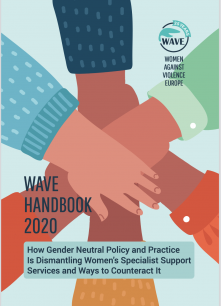WAVE Handbook 2020: How Gender Neutral Policy and Practice Is Dismantling Women’s Specialist Support Services and Ways to Counteract It

WAVE is excited to announce the publication of it’s 2020 Handbook by the Thematic Working Group on protecting women’s support services from gender neutral policy and practice.
This handbook was written by seven working group members with diverse expertise coming from various women’s organisations and European countries.
The purpose of this handbook is to inform employees and volunteers of women’s specialist support services (WSS) about the dangers of gender neutral policy and practice, as well as to help them counteract it by providing best practice examples which they can apply to their own region and organisation. As the reader opens the handbook to the first chapter, they begin their journey with background information about what gender neutrality is in the social, economic and political context, emphasizing the importance of intersectionality. The following chapter lets case studies solidify what strategies are needed in order to protect women’s support services from gender neutral policy. After this, the historical context of gender neutrality illustrates the causes behind the backlash against the gendered language of the Istanbul Convention in Bulgaria and Slovakia is discussed in Chapter 4. The reader will then learn more about techniques on how to navigate hostile spaces when one’s organisation is underfunded or not funded at all in Chapter 5. This is followed by a chapter on a case study of the UK which shows the impact of public procurement policy on specialist women’s organisations and Black and minoritised women’s organisations. The next chapter covers the responsibility of the state which is then analysed more closely by the examination of the Istanbul Convention, CEDAW and the European Convention on Human Rights, highlighting key areas relating to the comprehensive violence against women and girls (VAWG) approach by diverse states defining their responsibilities as signatories. Following this, promising communication strategies for the battle against gender neutral policies are underlined and analysed. These are illustrated by promising practices from several organisations which are then followed by short explanations of the outcome as well as pointers on how to use those strategies for your own organisation. The handbook ends with a chapter on self-care techniques for those who work in the field to combat violence against women. This chapter covers the deep and real meaning of health and how to put in place every possible action to prevent and treat vicarious trauma, giving priority to the self-care experience.